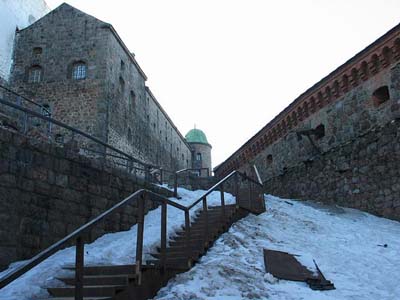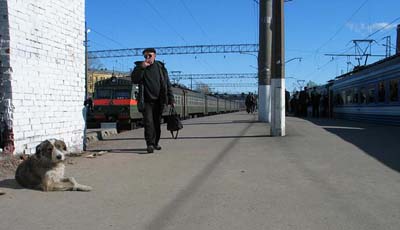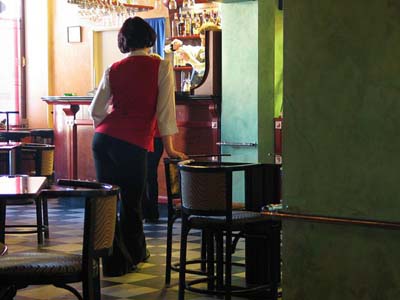Ordeals in Vyborg
A town boasting roots in the middle ages, basements drowning in feces, and enough crime to scare away Finns who refuse to travel with guards—what more could a tourist want?
A tiny TV news item catches my attention: Residents of Kholui, a village in the region of Ivanovo, are expecting to profit from spring flooding this year. They’ve launched a seasonal “Middle-Russian Venice” tour project, and now, in addition to buying the famous Kholui lacquered boxes, tourists can enjoy guided boat trips around the village’s flooded streets, gardens, and barns. So proactive in reacting to a calamity, these extraordinary people have managed to turn a major curse into a minor blessing—and, suddenly, I’m dying to visit Kholui.
But my knowledge of geography is pathetic (though I do adore maps; similarly, I’m horrified at the idea of flying but love pictures of airplanes) and I’m not too surprised when Ivanovo’s “Venice” turns out to be much further from St. Petersburg than I imagined. I decide to postpone this adventure till next year’s floods—but, as I continue to stare at Russia’s map, I suddenly feel I won’t survive another weekend in St. Petersburg.
I crave being a tourist.
And Vyborg—a small town with a medieval fortress an hour and a half northwest of St. Petersburg—looks miraculously close to St. Petersburg on the map.
“The fortress this” and “the fortress that”—and then, suddenly, “Vyborg is the unique and only West European town whose history goes back into the remote Middle Ages…” Then again: “The town has many tourist attractions—the ‘Vyborg Fortress’ State Museum (1293)…”—and many more, including “V. I. Lenin’s House Museum” and “objects drowned in the Gulf of Finland.”
Places are nothing but people: They are the houses and fortresses these people live in, they are the things people drop into water.

I used to have a friend from Vyborg, 18 years ago, when my mother and I lived in Moscow after Chernobyl. I google her name, Alla Goldberg, but nothing relevant comes up. A man with her father’s name, Rudolf Goldberg (which is hardly a common name in a place like Vyborg), seems to be still living and working there, however.
An article in the Nov. 29, 2002, issue of Vyborgskiye Vedomosti, a local newspaper, cites a letter from disgruntled residents of a historic apartment building: The door leading from the street to their stairway hasn’t closed since January because “the basement is drowning in feces. The stench is incredible, to say nothing of mosquitoes and rats.” And they blame it all on Rudolf Abelevich Goldberg, director of the “Municipal Unitary Housing Maintenance and Management Enterprise #3.”
Goldberg’s reply is cited, too: “I’ve been to this basement more than once…It’s impossible to drain it all with a pump. In spring, we spread chlorinated lime over it, and we’re going to do it again now. It works as a disinfectant and also helps the sludge to dry, so it could then be shoveled away. The sewers are so old here, you can punch them through with your finger. A local repair won’t be enough; what’s needed is a complete replacement…”
The article breaks my heart. I remembered Rudolf Goldberg as a handsome, cheerful, energetic man, a typical Soviet engineer, and it really hurts having to picture him handling the contents of fragile ancient sewers nearly two decades later. It’s also painful to have to dismantle an image of Vyborg that I’ve stored in my mind since 1986: once a Finnish town, a neat little place, green and orderly, a little bit like Finland, or Estonia.
In the English-language St. Petersburg Times I read about the boycott of Vyborg by over 20 Finnish travel agencies in January and February 2003. “Crime Wave Driving Finns Out of Vyborg” is an ambiguous headline, as it seems to allude to 1944, when most Vyborg residents fled to Finland, leaving a nearly empty town to the Soviet troops.
The story says that even though Vyborg relies heavily on the money brought in by Finnish tourists, it’s not always a friendly place: “Thieves are spraying tourists with pepper gas on the streets in broad daylight and making off with wallets, passports and cell phones… Groups of five to 10 are forcing their way onto crowded tour buses, robbing passengers and looting luggage compartments. Some boldly hunt up shaken victims and offer to sell back passports and cell phones.”
I’ve forgotten that too many taxis in a tiny town are somehow a sure sign that the town is famished.
And the attitude of Vladislav Krasnoperov, a Vyborg prosecutor quoted at the end of the story, further defies any cozy stereotypes of the famed Russian hospitality: “We have asked Finnish travel agencies to have security guards on buses, and we have received a categorical refusal. We ask Finnish travel agencies to have a police officer on buses and, once again, we receive a categorical refusal. Finnish officials justify this by saying Finnish tourists won’t want to travel on the buses, but, excuse me, what other measures can be taken if the Finns themselves don’t always want to cooperate?”
On the way to the train station the next morning, a cab driver and I are discussing the fate of Mikhail Khodorkovsky. Neither of us feels particularly sorry about the jailed billionaire: The driver has to work from four in the morning to seven at night every day to earn $1,000 a month, and as for me, I am determined to be a nonchalant tourist.
The driver says this isn’t the best time to go to Vyborg—the town’s not what it used to be. I recite to him another treasure quote from my research, the Vyborg District Administration’s description of the cathedral, built in 1418, destroyed during World War II: “Currently, this ancient building in the Old City is nothing but a gloomy ruin that serves as a solemn reminder of the horrors of war.”
“But the war ended 60 years ago,” says the driver, and we both laugh bitterly.
He also tells me about his Vyborg friend, a gangster who survived the wild post-Soviet transition period and settled down comfortably like many others. It was inevitable, he explains, that a place like Vyborg became so criminalized: a border town and a Gulf of Finland port, surrounded by first-class forests relied on by Finland’s paper industry. Finland, the driver says, is so small it would do anything to preserve its own resources; Vyborg bosses are happy to cut any tree to enrich themselves.
The train from St. Petersburg zooms through the industrial outskirts into what used to be Finland. Winter’s officially over—but the countryside is taking its time to recover: Snow mixed with dirt looks as stalwart as rock, and last year’s garbage blooms like spring flowers in the few snowless patches. Old wooden Finnish houses don’t look like they were built to last—or like they’ll last much longer. Every now and then we pass mansions of the nouveau riches, equipped with satellite dishes and barricaded from the rest of the world. Graffiti is everywhere, a cocktail of obscenities, soccer zeal, Russian nationalism, teenage rage, and last year’s parliamentary election slogans.
Every now and then, a sugary male voice reminds us of the “splendid” bar in car no. 6, complete with “sandwiches, fresh beer, other alcoholic beverages and cigarettes.” Along the railroad are the little stations that used to bear Finnish names and now serve as the addenda to the behemoth humanities textbook called St. Petersburg: Repino/Kuokkala, Komarovo/Kellomjaki, Zelenogorsk/Terijoki.
At one of these stations, I see three drunks across the platform from our car: a middle-aged man, a middle-aged woman, and a young man whose face is already acquiring the purplish swollenness that makes most alcoholics here resemble one another as people with Down’s syndrome do. A large, friendly dog is napping at their feet. The woman has three or four round bumps on her face, each the size of an average nose. She’s smoking and laughing.
When the sugary-voiced guy begins to lure us again for a morning beer, I feel like finding and killing him. But an hour passes and, finally, we arrive in Vyborg/Viipuri.
The train station parking lot is packed with taxis. I’m not aware yet that Vyborg is really tiny; I’m not yet reminded of all those tiny, poor Ukrainian towns I’ve visited, where taxis seem to outnumber the native population; I’ve forgotten that too many taxis in a tiny town are somehow a sure sign that the town is famished.

Saturday morning is sunny and chilly, and most people are sleeping in—so at first, I get to see Vyborg in its pure form, devoid of any bustle. The roads are in horrible condition, but that’s normal. The buildings are in horrible condition, too, and that’s normal and shocking at once.
I walk down the empty Fortress Street, past the deserted buildings with black holes in place of windows, and when I reach the fortress, I realize I’m the only human soul inside its medieval walls. The creepiness of it is so unbearable I begin talking to myself: “What the fuck are you doing here, Veronica? Let’s come back in a few hours. Maybe.” I turn around and flee, pausing once to take a picture of a huge, rusty thing lying on its side near the entrance, resembling an anchor or some device out of an ancient butcher’s shop.
To compare Vyborg and St. Petersburg is ludicrous yet pleasing. St. Petersburg is totally flat but it feels endless—Vyborg is hilly but microscopic. St. Petersburg is unkempt like someone too busy to comb his hair and shave—Vyborg is slovenly like a person suffering from severe depression. An eloquent epitomization of St. Petersburg’s spirit is the building which saw Denis Diderot as its guest in 1773 and Kazimir Malevich a century and a half later; both great iconoclasts-in-residence have been honored with memorial plates, and the building now houses the City Prosecutor’s Office. In Vyborg, the City Court shares the same entrance with the Tuberculosis Prevention Clinic and a footwear store; the court’s red plaque is stuck on the left from the door, the clinic’s green one on the right, and the windows on both sides are full of shoes.
At about 11 a.m., I decide a cup of coffee and a visit to the bathroom wouldn’t hurt. But the bars I pass look way below anyone’s hygienic standards, and I ignore them—and, 40 minutes later, I really wish Vyborg had a McDonald’s. This futile search gives me a new sense of purpose, however, and I end up catching some glimpses of the town’s dominant post-Soviet dimension.
There’s a striking number of banks here, as well as jeeps and other foreign-made vehicles with local license plates. Tourists from Finland abound, and babushkas—poor but businessy—swarm around their comfy buses, chatting in Finnish. Many shop signs are bilingual, too.
A movie theater called Rodina (“Motherland”) shelters a seedy slot-machine outfit called Eldorado. A movie theater called Vyborg Palace is currently playing “House of the Dead”—“The dead walk…You run.” A Russian Orthodox church, squeezed neatly between the St. Petersburg-bound highway and a gloomy boiler-house chimney, has a jumbo “Christ Has Risen!” sign on its fence year-round—in between Easters, it’s covered with a fishnet cloth.
The apartment building whose residents complained about shit in their basement is, comparatively, in perfect shape. Across the street from it is a funeral home. A little girl in a tiny white ballet skirt watches me from a window on the second floor; I take a picture of her, and she waves to me, without smiling. There’s too much sun, and the picture of the pensive, ghostlike girl doesn’t come out right. I erase it.
Eventually, I drink bad coffee and use the bathroom at a place called Bistro Voyage—sterile, humble in appearance but pretentious in design. I’m the only customer, so the waitress turns up the volume of a Russian pop FM station, squats by the counter and begins peeling a bucketful of potatoes. I sit by the window and study the fence across the street: erected around yet another wreck, it features two double-headed crowned eagles, the Russian emblem, painted over two weather-beaten Russian flags (rust instead of white at the top, black instead of red at the bottom).
I decide to go back to the fortress and, this time, I notice three very conspicuous monuments that I missed earlier that morning: a stark-naked Young Ranger, a totally naturalistic moose, and Lenin with a shy swastika at his feet, drawn (and then crossed out) in pink chalk. I spend some time at the market square, amazed at how lively this area has become since I last saw it: babushkas pace around their baskets and brooms, looking for clients; gypsy kids crowd around Finnish buses, waving goodbye to the tourists.

As I near Fortress Street, I’m overcome with unease. I turn around and follow a group of cheerful Finnish women into a bar; I spend the next hour and a half there, jotting down my impressions of Vyborg and drinking Finnish beer. It comes time to leave when two sturdy, mafiosi-looking men enter the bar and sit down at the table next to mine. They glance at me and my camera, order vodka and proceed with a conversation started outside. Most of it is Russian curses and business, business and curses, and there are some names, too, and I know I’m not meant to hear any of it. Maybe I passed for an ignorant Finnish tourist, one of the many in the bar, and I feel somewhat safe in this disguise—but not safe enough to stay much longer.
On the way back to the train station, tipsy and thrilled, I spot a sorry-looking babushka standing alone near a shoe store, trying to sell a pair of white shoes. The name of the store is Zolushka (“Cinderella”). I have an uncontrollable urge to take a picture of the old woman, but she turns away. I come up to her, push some change into her hand, and say resolutely, “Babushka, please, let me photograph you.” She nods, and thanks me. She’s not posing, she just continues to stand there, trying to sell her shoes—and I’m trying to get a nice picture of her. The sun is everywhere, and I’m tipsy, and the pictures don’t come out right—but I don’t erase them.
On a dusty wall not far from the train station I spot an ominous message sprayed in green: “Teach children to workship [sic] Putin! Fuck off America! Shaitan Akbar! [Satan is great!]”
